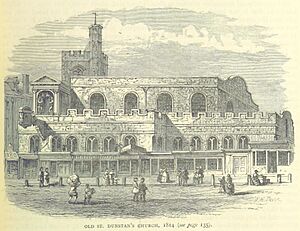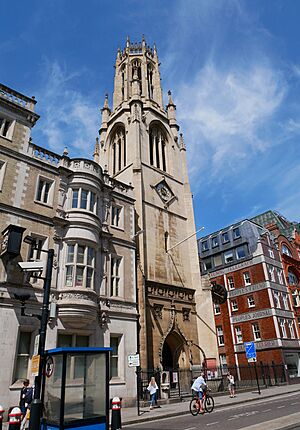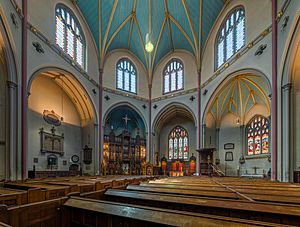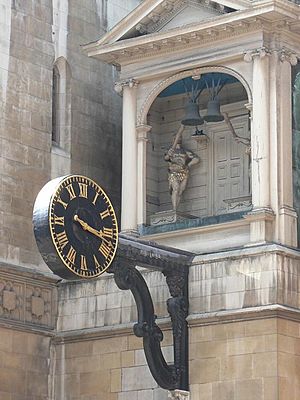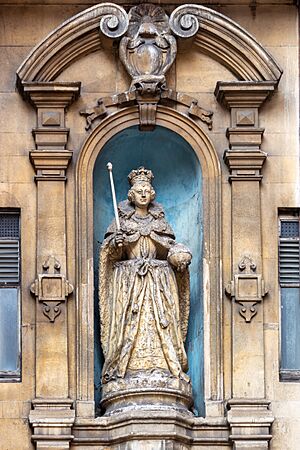St Dunstan-in-the-West facts for kids
Quick facts for kids St Dunstan-in-the-West |
|
|---|---|
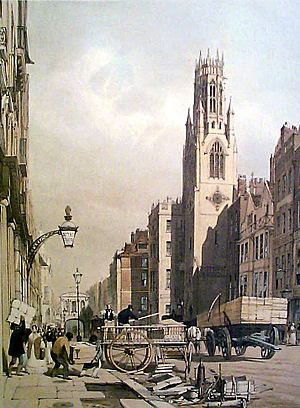
St Dunstan-in-the-West in 1842
|
|
| Location | Farringdon Without, City of London |
| Country | United Kingdom |
| Denomination | Church of England Romanian Orthodox |
| Website | www.stdunstaninthewest.org |
| Architecture | |
| Heritage designation | Grade I listed building |
| Architect(s) | John Shaw Sr. |
| Style | Neo-Gothic |
| Administration | |
| Diocese | London |
| Province | Canterbury |
The St Dunstan-in-the-West is a special Guild Church located on Fleet Street in the City of London. It is named after Dunstan, who was an important Bishop of London and Archbishop of Canterbury a long time ago. Even though the church has a very old history, the building you see today, with its unique eight-sided main area, was built in the 1830s. It was designed by John Shaw.
Contents
A Look Back in Time
The First Church Building
The church is first mentioned in records from 1185. We don't know exactly when it was first built. Some people think it might have been started by Dunstan himself, or by priests who knew him well. Others believe it was founded between the years 988 and 1070. There's also a theory that it was one of the very first churches in the area, even older than some inside the main City of London walls.
In 1237, King Henry III took control of the church and its money from Westminster Abbey. He then gave it to the "House of the Converts," which was a place for people who had changed their religion. This led to the church not taking care of its local duties very well.
Many famous people have been connected to this church. William Tyndale, who famously translated the Bible, gave talks here. The poet John Donne was once the vicar, meaning he was the main priest, and gave sermons. Samuel Pepys also wrote about the church in his diary.
The church almost burned down in the Great Fire of London in 1666. The Dean of Westminster quickly gathered 40 students from Westminster School. They formed a fire brigade and put out the flames with buckets of water. The fire stopped just three doors away from the church.
The old church building was changed many times over the years. Small shops were built right against its walls. The churchyard became a busy place for selling and publishing books. Later, repairs were done in a different style, making the church look like a mix of old and new. Its old arched roof was replaced in 1701 with a flat ceiling.
The Worshipful Company of Cordwainers, a group of shoemakers, has been linked to the church since the 1400s. They hold a yearly service to remember two important helpers, John Fisher and Richard Minge. After this service, children traditionally received a penny for each time they ran around the church.
Building the New Church
In the early 1800s, the old St Dunstan's church was taken down. This was done to make Fleet Street wider. A new church was then built on its old burial ground. Work began quickly in July 1831, based on designs by John Shaw Sr.. By August 1832, the last part of the old church was removed.
John Shaw designed the new church with an eight-sided main area because the building site was small. Seven of these sides have arched openings, with the altar at the north side. The eighth side leads to a short hallway, which goes under the organ to the bottom of the tower. This part serves as the main entrance. Above the arches, Shaw added a row of windows and a vaulted ceiling.
The church's tower is square at the bottom, then becomes eight-sided at the top. It looks similar to other famous church towers in England. John Shaw Sr. passed away in 1833 before the church was finished. His son, John Shaw Jr., completed the building.
The wooden rail around the altar is very old. It was carved by Grinling Gibbons when John Donne was the vicar (between 1624 and 1631). Some of the memorials from the medieval church were moved into the new building. A small part of the old churchyard still remains today.
The Church in Modern Times
The church was lucky during the London Blitz in World War II. It mostly survived, though bombs did damage the open tower at the top. It was damaged again in March 1944 during another attack on London. The church was mostly repaired by 1950.
In 2012, enough money was raised to put 10 new bells in the tower. The old bells had been taken out in 1969. On January 4, 1950, the church was given a special status as a Grade I listed building. This means it's a very important historic building.
The Famous Clock
On the front of the church, there's a special clock with figures of giants. These giants might represent Gog and Magog. They strike the bells with their clubs to tell the time. This clock was put on the old church in 1671. It might have been added to celebrate the church escaping the Great Fire of 1666. It was the first public clock in London to have a minute hand. The two giants strike the hours and quarter hours, and they also turn their heads.
Many famous books mention this clock, including Tom Brown's Schooldays by Thomas Hughes, The Vicar of Wakefield by Oliver Goldsmith, and several books by Charles Dickens like Nicholas Nickleby. It's also mentioned in The Warden by Anthony Trollope and the old story The String of Pearls, where the character Sweeney Todd first appeared.
In 1828, when the old church was torn down, the clock was moved. An art collector named Francis Seymour-Conway, 3rd Marquess of Hertford took it to his home, Winfield House. This house then became known as St Dunstan's. During the First World War, Winfield House was used as a place for soldiers who had lost their sight. The charity that helped them took the name St Dunstan's, which is now called Blind Veterans UK.
The clock was brought back to the church in 1935 by Harold Harmsworth, 1st Viscount Rothermere. This was to celebrate the 25th anniversary of King George V becoming king.
Statues and Memorials
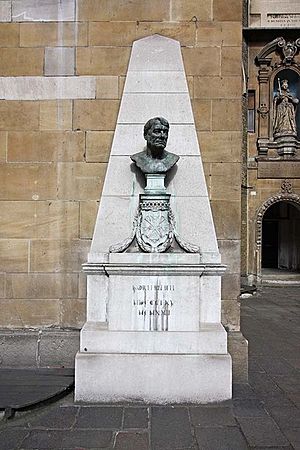
Above the entrance to the old school building, there is a statue of Queen Elizabeth I. This statue was moved from the old Ludgate gate when it was taken down in 1760. The statue was made in 1586 by William Kerwin, so it's from the time Queen Elizabeth I was alive. It's thought to be the oldest outdoor statue in London. The playwright Gwen John and her sister Winifred Jones worked with other women's rights activists to pay for its repair. Inside the porch below, there are three statues of ancient Britons, probably representing King Lud and his two sons.
Next to the statue of Queen Elizabeth is a memorial to Lord Northcliffe. He was a very important newspaper owner who helped start the Daily Mail and the Daily Mirror. Fleet Street was famous for its newspapers. This memorial was revealed in 1930. It was designed by Edwin Lutyens, and the bronze statue part was made by Kathleen Scott. Close by is another memorial for James Louis Garvin, who was also a key British journalist.
Near the font (a basin for holy water), there is a bronze memorial for Thomas Mudge (1715/16–1794). He invented an important part of clocks called the lever escapement and was a watchmaker for King George III. This memorial was made by Joanna Midgal and put in place in 2019.
Behind the iconostasis (a wall of icons) on the left side of the church, high on a wall, there is a marble memorial. It remembers the well-known 17th-century clockmaker Henry Jones (1634–1695) and his wife Hannah.
Romanian Orthodox Chapel
St Dunstan-in-the-West is one of the churches in England that shares its building with the Romanian Orthodox community. The chapel on the left side of the main altar is separated by an iconostasis. This special wall of icons came from the Antim Monastery in Bucharest and was dedicated in 1966.
People Connected to the Church
The church has links to many important people throughout history:
- Richard Lyst: A rector (priest) of the church who supported Anne Boleyn.
- Dr Thomas Campion (1567-1620): A doctor and a famous poet from the Elizabethan age.
- Philip Rosseter (1568-1623): A composer and close friend of Campion; both are buried here.
- Lord Baltimore: The founder of Maryland in America, buried here in 1632, along with his son.
- Matthew Bryan: A preacher who supported the Jacobite cause, buried here in 1699.
- Charles Gretton: A well-known London clockmaker and watchmaker, who was a church warden and buried here in 1731.
- Samuel Pepys: The famous diarist, who regularly attended services here.
- Edward Latymer: A churchgoer who was buried in the south aisle in 1627.
- John Calvert: A master ivory carver in the early 1800s.
- John Donne: The poet, who was the main priest here from 1624 to 1631.
- William Tyndale: A pioneer in translating the Bible into English, who gave talks at the church.
- Izaak Walton: A church official here.
- Thomas Mudge: The important watchmaker, buried here in 1794.
The church has often been mentioned in the legend of Sweeney Todd, the 'demon-barber' of Fleet Street. This is likely because the original story, The String of Pearls, says that Sweeney Todd's victims were thrown into a crypt at this church after they were murdered.
In Movies and TV
St Dunstan-in-the-West was shown as the "journalists' church" in the 2018 TV show Press. However, the real church for journalists is St Bride's.


